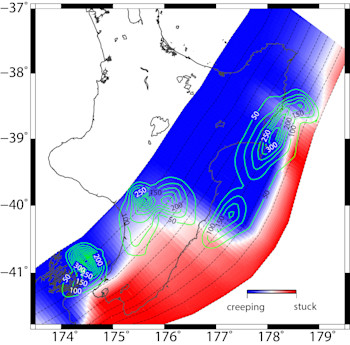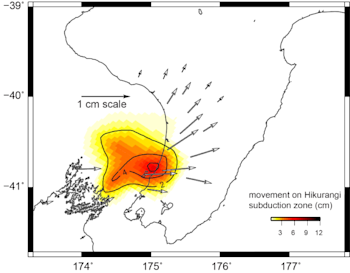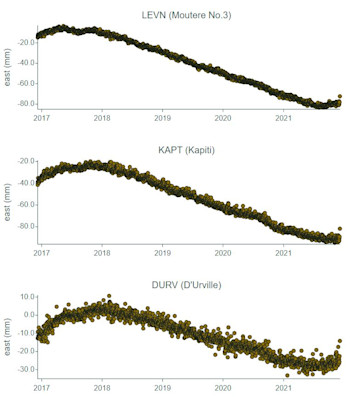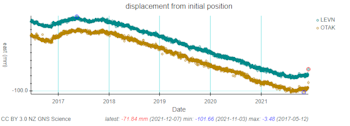
Kāpiti slow-slip event now underway
The part of the subducting Pacific Plate 30-50 kilometres beneath Kāpiti has started moving slowly again after five years of being ‘stuck’ to the overlying Australian Plate.
The Hikurangi subduction zone – the boundary between the Australian and Pacific Plates – extends along the east coast and dives underneath the North Island. We frequently have slow-slip events on the shallower part of the subduction zone off the east coast, but this time, it’s the deeper part under Kāpiti that is slowly slipping.
This slow-slip event began in mid-September under the Kāpiti-Horowhenua area and is expected to continue for several more months, as has been the pattern in this region in the past. We have recorded about six centimetres of movement on the plate boundary so far.
Slow-slip events are common in New Zealand. We see shorter events more frequently offshore the east coast, but these Kāpiti events typically only happen every five years or so and tend to last about a year. The last time a slow-slip event occurred in this area was after the 2016 Kaikōura earthquake.
The southern portion of the Hikurangi subduction zone is usually locked in place. This is the region below Wellington and Wairarapa, and is due to friction along the subduction plate boundary that keeps the plates from slipping past each other steadily.
Beneath the Wellington and Wairarapa regions, the plates have been locked together for a very long time — probably hundreds of years. The stress that is building-up between the locked plates will eventually be relieved by a large earthquake sometime in the future.
Deeper down on the plate boundary (beneath Kāpiti and Marlborough), the plates only lock together temporarily for a few years at a time, and then slip during slow-slip events such as the one occurring right now.
Slow-slip events can involve the same amount of movement on the plate boundary as a magnitude 7 earthquake, only they occur so slowly that no one would know. They can also produce some local felt earthquakes, although we haven’t observed any noticeable ones yet that we’d associate with this event.
The only way to measure and record slow-slip events is by looking at GPS data to see how the land is moving. These are the one type of earthquake you can’t measure with a seismometer!
You can view this GPS data on our slow-slip watch or geodetic data pages to pick up slow-slip events. When the plots start moving in the opposite direction to the normal trend – in this case, when the GPS points start moving east (or “upward” on the plot) – that’s when a slow-slip event is underway.
If you want to learn more about slow-slip events – this video explains how they happen.
We will provide updates as this slow-slip event progresses.
Slow-slip events are a great reminder that we live on a very active tectonic plate boundary here in New Zealand.
In the event of a large earthquake: Drop, Cover and Hold. If you are near the coast and you feel a Long OR Strong earthquake, get to higher ground or as far inland as you can once the shaking has stopped in case a tsunami was generated. For more information on how to get prepared, visit the National Emergency Management Agency’s website getready.govt.nz.
Attributable to - Laura Wallace – GNS Science Geophysicist
Media enquiries - media@gns.cri.nz or 021 574 541








